Assassin’s Creed Mirage’s ending is one of the best in the series since Ezio Trilogy & Assassin’s Creed IV: Black Flag, and I’m here to tell you why. For the first time, we see the origin of a reborn Isu as they come to terms with their past life and memories. We’ve seen reincarnations before, like Germain in Unity and Roberts in Black Flag, and even Eivor in Valhalla was a reincarnation of Odin. But Odin could never take over Eivor, instead establishing a relationship of mutual respect. On the other hand, Basim willingly embraced his true identity as Loki, which was the purpose of the “Mead” he drank.
Loki is the only member of the Æsir to have been fully reincarnated with his knowledge, apart from Svala, the rebirth of Freyja. This can be confusing for players who haven’t played Valhalla, especially given the rushed ending of Mirage. Without the context of Loki’s Æsir lore, it’s difficult to understand how Basim’s demeanor suddenly changes from a curious knowledge seeker to a confident and cunning mastermind. The game’s ending also doesn’t fully explain how Basim combines his two personalities or why he wants to find others like him.
The following content has MAJOR SPOILERSfor Assassin’s Creed Odyssey, Assassin’s Creed Valhalla and Assassin’s Creed Mirage.
After playing Mirage, I believe Basim’s character arc is one of the most tragic and well-written in the series, rivaling even Edward Kenway’s, though falling short of Ezio Auditore’s legendary saga. In this article, I will dissect the ending of Mirage in detail, providing essential context for new players.
Here are the major spoilers that are essential to our content:
- The final confrontation between Roshan and Basim
- The final scene in the Isu temple
- The actual identity of Nehal
- What Jinni (Djinn) means to Basim
Assassin’s Creed Mirage Ending Explained: Basim’s Transformation into Loki
Assassin’s Creed Mirage’s ending shows us how Basim, a cunning young street thief in 9th-century Baghdad, discovers his true identity as the recreation of an Isu; the one Norse revere as the trickster god Loki. Embracing his new destiny, Basim is on a perilous journey to reunite with his true love, Aletheia, and his children. He also vows to confront the “mad one” (Odin).
The ending is a lore-heavy puzzle that will leave many players scratching their heads, but it’s worth experiencing for the die-hard Assassin’s Creed fans. This ending might confuse many players, especially if they have not played until the end of AC Valhalla or have forgotten the story’s nuances. There are a few main things revealed in Assassin’s Creed Mirage ending:
- Roshan knows about Basim’s “more than a man” nature.
- Basim remembers his Isu past and torture.
- Basim’s embracement and transformation to Loki.
- Basim sets out to find his beloved, his children, and even the ‘mad one’ (Odin).
We break down the above points from the game’s ending cutscene. I am attaching the clip if you want to refresh your memory before delving into the details.
Roshan Knows Basim’s True Identity
After the incident at the Winter Palace, Basim accidentally killed Al-Mutawakkil with a dagger in self-defense. The following day, Roshan meets Basim and asks him about the “Precursor relic” he stole. You can see the facial expression on Roshan’s face when Basim tells her, “That object. It did something to me. I was… somewhere else. Cold. And frightened.”
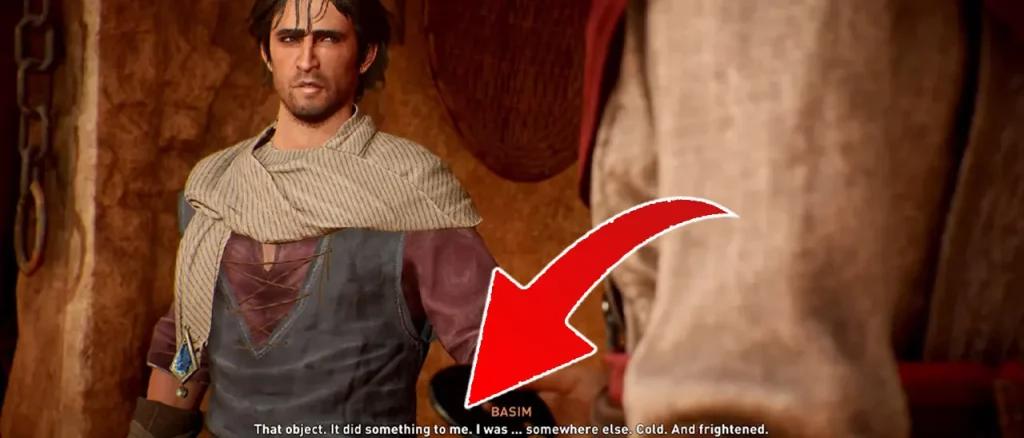
The camera hides Rohan’s face so as not to spoil the ending to the audience. Roshan realizes Basim’s veins coursing with the blood of the Ancients (due to the Mead and Yggdrasil; we will mention this later in this article). She realizes Basim is a key piece in the Order of the Ancients’ puzzle. So, Roshan invited him to go with her to hide Basim from the Order.
Before the assassination mission of the head of the Order, Qabiha, Al-Bahamut, Roshan was both unwilling and hesitant to send Basim. But after much convincing from Basim, she reluctantly agrees and tasks him with the mission.
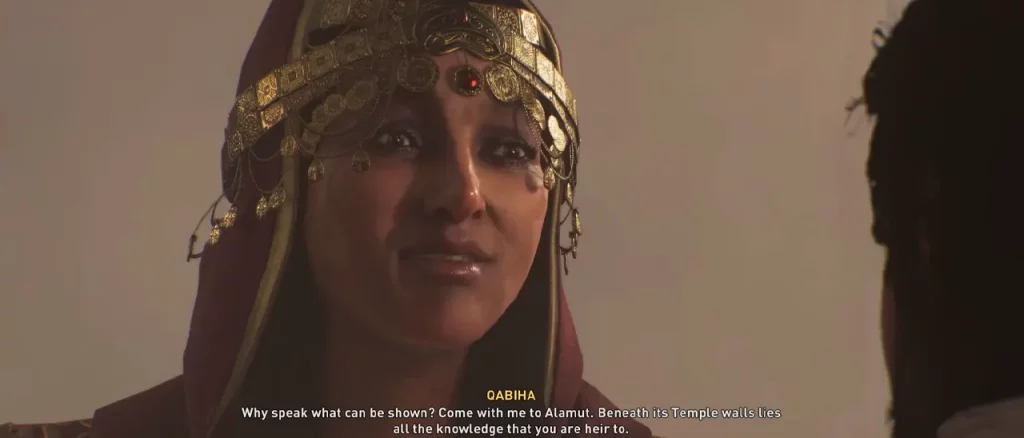
Before Basim could strike the killing blow, Qabiha tells him, “Come with me to Alamut. Beneath its Temple walls lies all the knowledge you are heir to.” Qabiha learned Basim’s truth from her son Abu’Abdallah (Qabiha was Caliph Al-Mutawakkil’s concubine), who was present at Winter Place when Basim killed his father.
But before Qabiha can tell anything more to Basim, Roshan kills her. We learn that Roshan followed Basim and witnessed exactly what she feared. She warns Basim not to be persuaded by Qabiha’s words, and if he does, Roshan will be one to kill him.
Nehal’s True Identity Revealed
In Assassin’s Creed Valhalla, we learn that Basim Ibn Ishaq is the reincarnation of Isu called Loki. We also discovered that some of the Æsir used the Yggdrasil supercomputer to upload their consciousness into the human gene pool to escape the Ragnarök & Great Catastrophe. Loki managed to sneak into the Yggdrasil laboratory and use the catalyst to be reborn as Basim thousands of years later.
At the end of Assassin’s Creed Mirage, Basim reaches the Isu temple beneath the Assassins’ fortress in Alamut, driven by a thirst for answers. Nehal, his enigmatic companion, helps him open the door, claiming that his blood is the key and that she “just knows” how to do it. But as they enter the temple, Nehal vanishes, leaving Basim alone to face the secrets within.
Basim discovers a strange-looking machine with a figure trapped inside screaming for help. He opens the device and finds Nehal, her eyes wide with fear.
As the truth unfolds, Basim realizes Nehal is a figment of his imagination, a manifestation of Loki’s consciousness. A side of himself he has resisted until now. She is a reflection of who he once was, a reminder of his true nature.
Basim’s conversations with Nehal are nothing more than internal dialogues, his subconscious wrestling with the dual nature of his identity. Every action she takes, every word she speaks, reflects Basim’s thoughts and feelings, filtered through the lens of Loki’s consciousness.
When Nehal stabs Caliph Al-Mutawakkil in the neck, Loki acts through Basim, driven by his primal urge to survive. For Loki, self-preservation is paramount, and he will stop at nothing to protect himself, even if it means sacrificing others.
Reviewing the cutscenes, we see that no other character in the game ever interacts with or acknowledges Nehal’s presence. Loki/Nehal knew this and avoided interacting with anyone other than Basim.
Nehal is unseen and unheard by all but Basim. Loki has carefully crafted this illusion, knowing it would be the most effective way to manipulate and control Basim’s traumas associated with being a Sage.
Even Samarra, Basim’s birthplace, was chosen by Loki. Samarra is just 950 km or 590 miles from Alamut Castle, built upon his prison. This is why all the other Æsir was reborn in northern Europe, their previous domain, but Loki was reborn in the Near East.
Implications of Nehal’s Ending
If you haven’t played Assassin’s Creed Valhalla, then the ending of Nehal’s arc in the prequel Assassin’s Creed Mirage will be a lore-shattering revelation, confirming that Loki has been controlling Basim from the shadows all along. It is a testament to Loki’s cunning and skill as a trickster.
The ending then proceeds to set the stage for an epic clash between Basim and the other Isu reincarnations, including the Mad One (Odin) in Assassin’s Creed Valhalla.
The Significance of the Jinn to Basim
The Jinni (Djinn) manifests Basim’s hidden fear and suffering he endured as Loki—the personification of the Guard that tortured him when he was a prisoner. Basim realizes the room he is standing in is a prison. And he was a prisoner there. This entire room filled out with otherwordly technology is meant to torture him. And Jinni is no other than Skaði, the Guard assigned to torture Loki until the end of the days.
The first clue is hidden within the memory seal. When the Loki says, “srræsnos! dű hm làygw r zárhasi!” (which is translated for us by Nihal as “Hrgh! Enough! Let me out of here!”, you can hear the female voice of the Guard saying, “Seylos!” (meaning silence in Proto-Indo-European *seyl-).
As per the lore, the Isu language is the common ancestor of all of the languages in the Indo-European language family. The Assassin’s Creed team constructed the Isu language from reconstructed Proto-Indo-European (PIE) vocabulary. To fill in the blanks, they drew inspiration from Old and Classical Latin, Ancient Greek, and Sanskrit, creating a language that is both familiar and alien.
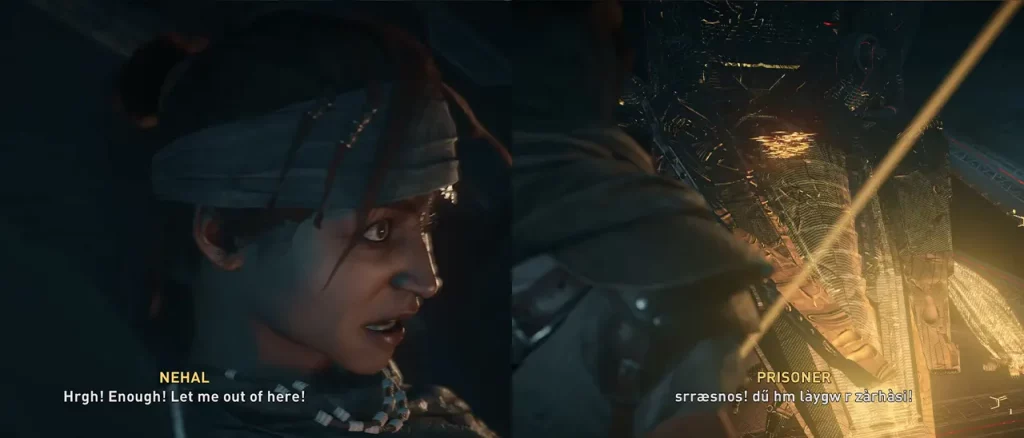
The Prose and Poetic Eddas, ancient Norse texts, tell the tale of jötunn Skaði, who tortures the bound Loki by placing a venomous snake above him. In Assassin’s Creed Mirage, the second clue is the dagger the Guard holds, its blade bearing a cutout resembling serpent fangs. A chilling reminder of Skaði’s cruelty, the dagger hints at the torments awaiting Basim.
In the Norse myth of Loki’s Binding, Thor repeatedly silences the trickster god with a single word, þǫgn (“silence”). This seemingly simple act is a powerful reminder of the Æsir’s disgust for Loki’s deception and trickery. It also suggests that Loki’s silver tongue has finally failed him, leaving him bound and powerless. The Isu Skaði using “Seylos!” (“silence”) shows how both Æsir and Skaði are unwilling to listen to Loki’s pleas, preferring to silence and torment him until the Great Catastrophe.
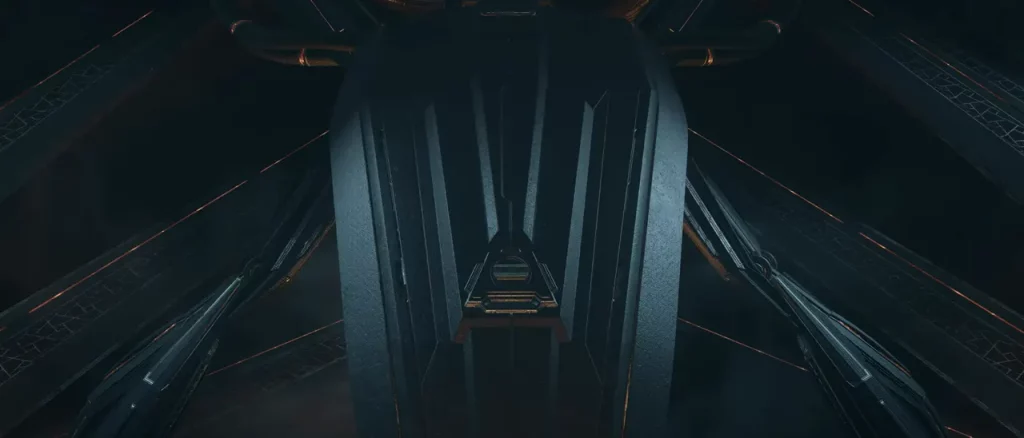
In the Isu realm, Loki’s punishment echoes the Norse legend of his Binding. With its writhing tendrils, the prison pod mirrors the entrails that bind him in myth. The dagger held by the Guard, with its serpent fangs, represents the venomous snake that drips venom above him. The Guard herself is a spectral embodiment of Skaði, the giantess who torments him in the Eddas.
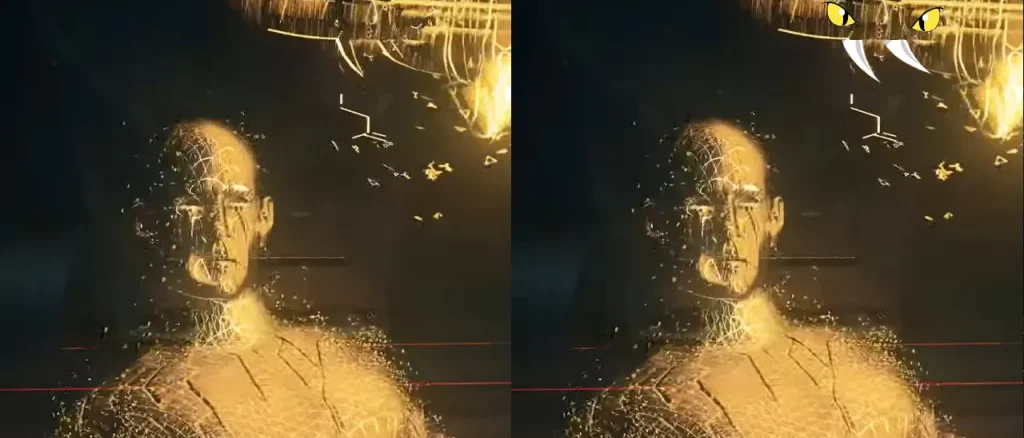
To unravel the mysteries of the binding of Loki, we must delve into the Norse myths passed down as legends from the time of Isu, as per the Assassin’s Creed universe. These tales, echoing through the ages, offer a glimpse into the deepest fears and the lingering trauma of Loki’s life as Skaði’s prisoner.
Binding of Loki (Norse Mythology Version)
Binding of Loki is essentially the end of Loki’s saga till he emerges from his chains for the Ragnarök. As the story goes, Loki is brought to his knees by Thor for his role in the death of Baldur, the beloved son of Odin. Thor succeeded, and during Loki’s captivity, Thor told him to be silent at least four times, threatening him each time with Mjöllnir.
Now we know the Isu word for Silence is “Sylos,” which is the Guard in the Mirage ending cutscene in Loki’s prison. This could be interpreted as a hint that the Guard is Thor. However, the Guard’s female voice suggests that she is Skaði.
After his capture, Loki was bound with the entrails of his son Nari, and his son Narfi was changed into a wolf. Skaði fastened a venomous snake over Loki’s face, and its poison dripped on him until Ragnarök.
Norse mythology has different versions of this story so some details may vary. But the overall story is that Loki was punished for his crimes by being bound and tortured until the end of the world.
Binding of Loki (Isu Version)
The Nornir, three wise women who read the Calculations regarding the future timelines, informed Odin of the grim future that awaited the Æsir and Vanir. Most readings showed the same inevitable outcome: a final battle where the Jötnar and other Isu factions would attack Asgard, wiping out most of the Asgardian Isu before the Great Catastrophe.
During the war between Asgard and Jotunheim, Jötnar Isu Loki and Jötnar Aletheia fell in love. Their love was forbidden, as he married Sigyn and aligned with the Æsir through his blood-brother Odin.
Loki and Aletheia were both convinced of their inevitable doom. All six solutions to the Great Catastrophe had failed, and they knew that the end of their love was coming.
As the Dikastes of Atlantis, Aletheia had personally known the Capitoline Triad, the three Isu scientists working on solutions for the Great Catastrophe. She had access to the fifth and sixth solutions and the data of the Olympos Project, which she despised.
Knowing the end was near, Loki and Aletheia decided to have children together. They wanted to ensure their love would live on, even in the post-catastrophe world. They gave birth to three children: Fenrir, Hel, and Jörmungandr.
Calculations showed that Loki and Aletheia’s children were destined to play a pivotal role in Ragnarök.
Due to his role in Ragnarök, Odin orders Fenir to be imprisoned till the end of the Isu days at the Great Catastrophe. Loki believes this is unfair as this is an ‘invented crime’ due to various possibilities and altered timelines in Calculations. So Fenrir is being imprisoned, even though he has not yet committed the crime for which he was being punished.
As a retaliation, Loki devises a plan to kill Odin’s son, Baldr. In the Assassin’s Creed universe, there are two variations of Baldr’s death. In one version, Loki poisons Baldr with mistel-berries. In the other version, Loki uses the Muspels, a race of fire giants, to capture and kill Baldr.
Seeking vengeance, Odin cast Loki into a remote Isu prison at the far edge of Jötunheimr, to be tortured day and night by the jötunn Isu Skaði till the Great Catastrophe. Odin chooses Skaði because she hates Loki as much as he does. Because Loki is responsible for setting in motion a chain of events that resulted in the death of Skaði’s father, Þjazi.
The binding of Loki was told to Layla Hassan and us players through Animus Anomalies puzzles in AC Valhalla. During the puzzles, we hear Loki and his lover, Aletheia, talking. So, we will present the conversation on which we based the events upon it.
Hlutrholt (Memory Fragment)
In this conversation, Loki learns about the ‘seventh solution’ to survive the Great Catastrophe:
- Aletheia: I’ve spoken with the Mother, the Father, the Sacred Voice. They have assured me their success is imminent. Our people will survive the cataclysm.
- Loki: Six times they have tried to save us. Six times, they have failed. Forgive me if I have my doubts.
- Aletheia: The Mother is working on a seventh. A bold solution… risky. But she is confident it can work.
- Loki: And what does the Father say? Or the Voice? They are strangely silent these days…
Thornburg Henges (Memory Fragment)
- Loki: Curse that Mad One, that one-eyed wretch! He has taken our son! Imprisoned him for invented crimes and locked him away!
- Aletheia: As he said he would love. Do you not remember his threats? You should have been more careful.
- Loki: Have we no power to stop him? To save our son? No recourse?
- Aletheia: What can we say? And to whom? Must the world know about our children? Must your wife learn of us? Is that a risk you want to take?
- Loki: I must do something! Anything!
Quartzite Ridge (Memory Fragment)
- Aletheia: My love, what happened? You are flushed trembling.
- Loki: An eye for an eye. A son for a son. If ours must suffer needlessly to the end of his life, so will his tormentor.
- Aletheia: What… what have you done?
- Loki: The poor boy collapsed so suddenly. Felled by the faintest taste of mistel-berry. With his father standing over him, weeping!
- Aletheia: Reckless, foolish! Were you seen? Do they know it was you?
- Loki: (laughs)
Kildesbig (Memory Fragment)
- Aletheia: Wake, my love, wake! Soldiers at our door. They’ve come for you! For us.
- Loki: Let them take me. I have no more fear. Let me air my wrath in the courts.
- Aletheia: They’ll kill you before they let you speak!
- Loki: I’ll appeal to the Council. They must know what the Mad One has done.
- Aletheia: They’re upon us! Now is not the time!
Briudun Hill (Memory Fragment)
- Aletheia: Have you heard? The High Council has stripped the Mother of her title for gifting our tormentor her seventh method of salvation.
- Loki: The seventh method? Is it viable? Why were we not told?
- Aletheia: I’ve heard whispers and rumors. It seems the seventh requires a human host.
- Loki: A human host? Do you mean… rebirth? As one of them?
- Aletheia: Yes. But it’s a small loss for a greater gain. A risk we must be willing to take.
Aqueduct (Memory Fragment)
- Loki: The Mad One is away, wandering in lands afar. He searches for a way to resurrect his son. Asking every leaf and stone for answers.
- Aletheia: We can use this to our advantage. To steal the seventh, the seal and its catalyst.
- Loki: It should be ours. For all the suffering he has wrought.
- Aletheia: Our minds are attuned, love as sympathetic strings.
- Loki: When the time is right, just right, we’ll go.
Basilica Ruins (Memory Fragment)
- Aletheia: Ah! Stop… stop!
- Loki: Keep still, love. You’re injured. Now let me see…
- Aletheia: Ah! No… no more, please. Let me… let me die. Here. Where all is quiet.
- Loki: No! This is… this is NOT your end. There is a way. A Piece of Eden, a staff attuned to this method of transfer. It may work!
- Aletheia: Or I may end up like the outcast’s husband—a beating heart without a mind. But do what you must… I see no other way.
Needham Lake (Memory Fragment)
- Loki: Be still, love. And let the current flow. Let it take you.
- Aletheia: Is this…? This is dangerous. It may not work.
- Loki: Until we have the serum, this is all we can manage.
- Aletheia: Will you not ask the Mad One for me? Ask him for the serum. Beg him for it.
- Loki: He would not listen. And I would sooner see our world obliterated before I gave that man a view of me on my knees.
Seven Sisters (Memory Fragment)
- Loki: My love, are you there? Speak and tell me you live.
- Aletheia: I… I live… if this is living—a mind without a body.
- Loki: And do you feel?
- Aletheia: I feel myself. My sense of being. Nothing more. Nothing less. No pain or… or joy… or passage of time.
- Loki: And yet, you are with me. And I am with you. And together, we will endure.
The Needles (Memory Fragment)
- Loki: My love, the time is now. The cataclysm is upon us. The Mad One has gathered his trusted eight to his secret hall.
- Aletheia: Remember the Calculations. You must act with precision. Every small step must be accounted for.
- Loki: I’ll remember. They are burned into my brain.
- Aletheia: How long till your rebirth?
- Loki: A long time, love. You must wait in your endless present, and I will sail the black sea of nonbeing. But if all goes well, I’ll find you again on the far side of our doom. We’ll be together. Again.
Implications of Jinni’s Ending
The Jinni started appearing to Basim in his youth, and it continues to haunt him till now. From previous games and databases, we know that Sages are born with unique personalities and memories, but they also inherit the memories of their Isu ancestors. These memories often manifest as visions during adulthood or childhood, which can be a traumatic experience.
For Eivor, these memories haunted her as in the shape of a giant wolf (Fenrir) and her betrayal towards Sigurd in losing his hand. Because for Odin, this was something he never expected from Týr. The highest sacrifice any Isu in the nine realms is made on Havi’s behalf, even when Týr says, “It was not for you,” looking at Fenrir.
Basim, born in the Arabian Empire of the Abbasid Caliphate, was brought up in the culture and beliefs of the nation he was born in. As per Arabic belief, Jinni can scare people who trample their homes or accidentally kill a related jinni. Loki trampled Skaði’s family in this case and killed Baldr, an Isu.
Loki’s Transformation: How Basim Helped the Trickster God Grow
Now we know that Nehal is the personification of Loki living within Basim. This is why her dialogue since the beginning of the game is meant to keep Basim safe, and if he is up to take any risk in life, she urges him to do it for himself.
Here’s where we see the differences in the ideology of both characters. Basim has a “sense of duty” and believes in the “enrichment of the soul.” Basim believes in standing up to their oppressors as the Hidden Ones do.
Loki or Nehal is different. Nehal hates it when Basim runs ‘errands’ (as Nehal calls it) for a few Dirhams. We can even see Nehal trying to hold Basim back when she thinks he is taking unnecessary risks. But Nehal cares for Basim. When Basim talks about his father, or how he was to improve the lives of the people around him, we can see Nehal sympathizing and sometimes being proud of him.
We see Loki’s self-preservation turn into caring for Basim’s life. An emotion Loki only had for Aletheia and their three children. Till comforting Eivor, Basim cared, suffered, and fought against the Order of Ancients to help humans as a Hidden One. An idea that changed Loki from a former Isu to the shield of men against the Order who followed the ideology of the Isu. Something Basim taught him in
We see this growth of an Isu who hated humans and even said, “A human host? Do you mean… rebirth? As one of them?” referring to the seventh method in disgust to someone who started caring for humans like Haytham and more. In Mirage, we even see Basim demonstrating a Leap of Faith to a young Hytham from the top of the minaret Al-Mi’dhana Al-‘Ateeqa so that Hytham could follow him down to safety. A teacher-student feeling that Loki & Basim even was carried in Assassin’s Creed Valhalla.
Isu Lore 101: Everything You Need to Know About Assassin’s Creed’s Ancient Gods
We must get one thing straight to understand the lore and meaning completely. Odin, All-Father, the one they call Havi, is the main villain of the current Assassin’s Creed story arc. This doesn’t make Eivor Varinsdottir a villain in any way. This is because Eivor Varinsdottir is not the complete consciousness of All-Father Odin. Yes, Evior inherited the DNA of Odin, but she did not let Odin take over her mind, unlike how Basim Ibn Ishaq accepted and united with Loki as his past.
All of this may be a bit hard to grasp easily. So, we will divide the answer into different parts and explain each. We must combine the story elements from previous AC games, Valhalla, and Norse mythology to understand Loki and Basim’s arc. So here are the basics needed to understand the ending of Assassin’s Creed Mirage fully:
- What is the Great Catastrophe, the First Disaster?
- Æsir Isu Ragnarök (Twilight of the Gods)
- What Were the 7 Isu Solutions to the Great Catastrophe?
- What is Mead & Yggdrasil?
- Why is Eivor Not Odin Like Basim is Loki?
- Project Anthropos & Homo Sapiens
- Olympos Project & Hybrid Beasts
- Nornir’s Prophecy & Nature of Fenrir, Jörmungandr, and Hel
- Why Loki Smuggled Builder?
- How Baldr Died
- How Baldr Survives Ragnarök & Great Catastrophe
- Bondage of Loki (the True Meaning of Mirage’s Ending)
- How Yggdrasil Works
- How Aletheia Manupulated Layla
The Great Catastrophe: The Day the World Ended (and Began Again)
The Great Catastrophe, also known as the First Disaster, was a cataclysmic event during human prehistory that occurred around 75,000 BCE, or 2306 IE (Isu Era). It was caused by a coronal mass ejection, which flipped Earth’s magnetic field polarity and exposed the planet to the Sun’s deadly radiation. This event happened during the Human-Isu War.
The Great Catastrophe devastated the planet, rendering the surface barren and killing only a few thousand humans and Isu. It was a near-mass extinction event for both species, but it also led to a peace treaty between the survivors. With their combined knowledge and resources, the remaining humans and Isu began to rebuild the world.
Ragnarök: The Twilight of the Gods and the End of Asgard
The Æsir and Vanir Isu: The Lost Scandinavian Gods of Assassin’s Creed
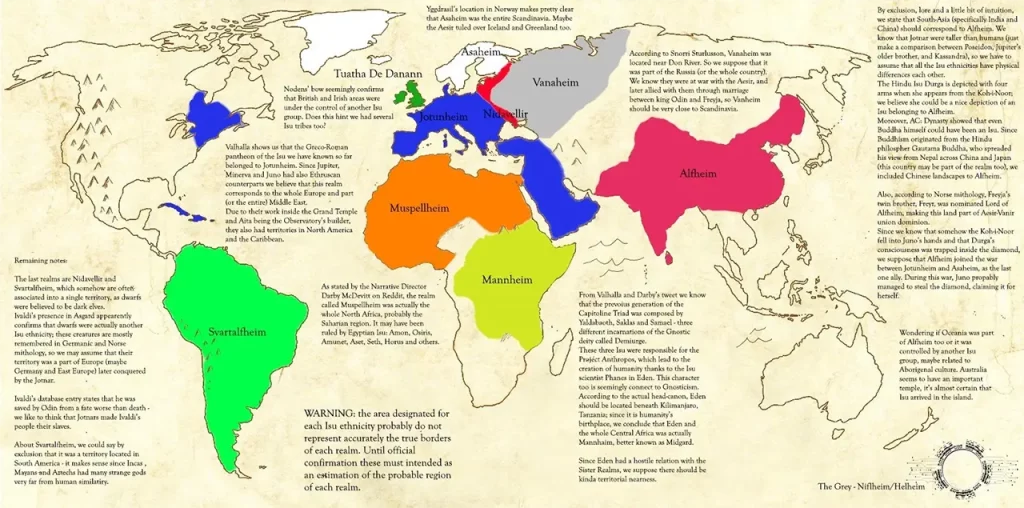
The Æsir and Vanir were two powerful factions of Isu who ruled over Scandinavia. Due to their overlapping territories and spheres of influence, the two groups came into conflict, resulting in the Æsir-Vanir War.
The war ended after a political marriage was arranged between the Vanir goddess Freyja and the Æsir king Odin. Eventually, the Vanir were absorbed into the Æsir, and their combined members include Odin, Freyja, Týr, Thor, Heimdall, Baldr, and more Norse gods from the current Æsir-Vanir pantheon.
During this time, Loki an Isu from the jötnar faction, became blood brothers with Odin. He even married Sigyn, one of the Æsir. However, this blood bond would eventually be tested when the Nornir, the three fates, prophesied Odin’s death, and all signs pointed it toward Loki’s descendant.
This prophecy sowed distrust between the blood brothers and set the stage for the eventual demise of the Æsir and Vanir. Loki turned into a cunning and mischievous mind to protect his family.
Ragnarök: The Inevitable Doom of the Norse Gods
Ragnarök happened as prophesied because Odin, with help from Isu Juno, stole a serum called Mead from the Jötnar, a powerful faction of Isu from Jötunheimr. Odin decided only to save himself and the other seven Æsir gods from the Great Catastrophe. So, he decided he didn’t want to save any other Isu’s genetic memory. Odin was willing to let all other Isu factions, including Loki and his children, die in the Great Catastrophe.
This led to a great war known as Ragnarök, where both sides suffered heavy casualties. Jötnar, Muspels, and Hel’s armies, led by Loki and his children, successfully destroyed Æsir-Vanir and einherjar that followed them.
This happened right before the Great Catastrophe hit Earth. In the end, the prophecy was fulfilled, and Ragnarök came to be true, with major casualties on both sides, including the death of Odin as prophesied.
But before their demise, Odin and seven of his most trusted Isu followers, including Tyr, Loki, Freyja, Heimdall, Thor, Sif, Frey, and Idun, uploaded their genetic memories via DNA into Yggdrasil, the World Tree.
Loki also managed to sneak into the Yggdrasil laboratory room and upload his consciousness into the human gene pool. This helped Loki be reborn as Basim, just like other Asgardian Isu reincarnated as humans thousands of years later.
7 Ways the Isu Tried to Save Themselves from the Great Catastrophe
Isu, in response to the Great Catastrophe, devised seven solutions to prevent the disaster:
- Build four towers to collect the solar flare into the Grand Temple and eliminate it. One of the incomplete towers, Eitri Tower, is still in Svartálfaheimr.
- Produce and deliver the Ring of Eden to all Isu citizens. The Ring of Eden was a Piece of Eden that projected an electromagnetic field to deflect magnetic projectiles and energy-based weapons discharges.
- Use all Apples of Eden from space to control the entire human species to believe in the same idea of safety, making the idea a reality.
- Use time travel and inform the Isu in the past about the Great Catastrophe so they can find new solutions to face it.
- Transform Isu bodies to withstand solar radiation. Juno’s husband, Aita, volunteered to test this method.
- Create machines/objects to store an Isu’s consciousness and retrieve it after the disaster.
- Allow the Isu’s consciousness to be reincarnated through the human species. This involved using a catalyst known as the Mead and the powerful supercomputer Yggdrasil to store and preserve an Isu’s genetic memories in the human gene pool.
But all these solutions failed on a grand scale due to different reasons:
- As per Isu’s Calculations, all four towers could not be completed in time.
- The Rings of Eden project was too large and impractical.
- Using the Apples of Eden to control humanity from orbit failed.
- The Isu ran out of time to build a time machine.
- Aita, Juno’s husband, volunteered to test the fifth solution, which involved transferring his genetic memory into another body. The experiment failed, but it led to Juno joining forces with Odin and using the Mead (seventh solution) to create the Sages of Aita. This allowed Aita to reincarnate as a human repeatedly over thousands of years.
- The sixth solution, which involved transferring consciousness into and out of vessels, failed because the technology could not be developed properly.
- Many of the high-ranking Isu feared that the seventh solution would eventually destroy humanity, so they banned the use of the technology. Only a few people, such as Odin, seven of his Æsir, and Basim, managed to use the seventh solution before the Great Catastrophe.
Mead and Yggdrasil: The Nectar of the Gods and the Tree of Life
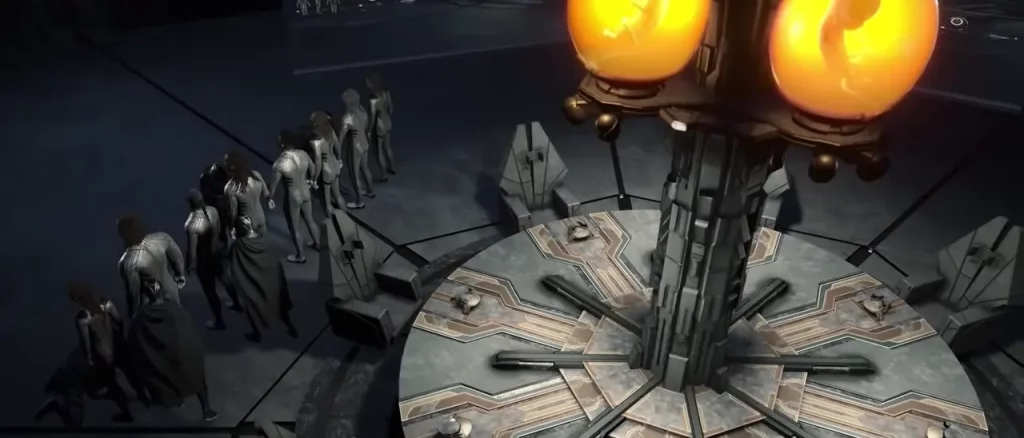
The seventh and final solution devised by the Isu to survive the Great Catastrophe was the Mead, a catalyst serum used in simultaneousness with the Yggdrasil supercomputer. When utilized alongside Yggdrasil, the Mead could preserve an Isu’s consciousness, allowing them to reincarnate as humans in the faraway future.
With the help of Juno (shown as jötunn Hyrrokin in Eivor’s visions), Odin stole the Mead from the Grand Temple. Juno becomes desperate to save her husband Aita’s genetic memory and envious that humans will endure, but Isu won’t.
Odin then sacrificed his left eye and mixed it into the Well of Mímir to make the catalyst needed to trigger the Mead. The catalyst will implant an Isu genetic source in humans, which could modify their genetic makeup, body, and mind into a replica of an Isu.
Juno also successfully uploaded Aita’s memory into the human gene pool, allowing AIta to be reborn as a different character many times in human history. These reincarnations include Germain from AC Unity, Roberts from Black Flag, and many more.
Why Basim Embraced Loki, but Eivor Resisted Odin

As the seventh solution was never tested before, there was something the Isu did not properly consider or forsee in their Calculations—the hope and willingness of humans. From the beginning of slavery, the spark that burned inside humans that led to the rise of the slave rebellion was hope.
The success of the event solution, unknown to Isu at the time, relied on eagerness. And the persistence of the Isu consciousness in the human mind, where it is trying to stabilize. We can see this in Sages of Aita, where many individuals became mad with their minds eventually ripped apart as Aita’s memories and personality gradually overtook the humans. That’s one of the reasons we have very few successful Sages of Aita through history, even though the probability of possible sages is much higher as per Abstergo Industries database.
Odin tried to be accepted by Eivor. When the wolf bit young Eivor’s neck, Odin’s memories and voice haunted her. After killing Kjotve, Odin revealed himself to Eivor in a vision. He accompanied her during all the major decisions in her life.
Odin wasn’t trying to take over Eivor’s mind but to make her accept their destiny and live out the rest of her life in Valhalla, a simulation created by the Isu. Eivor refused, and a fight ensued. She rejected Odin’s consciousness.
Only in the final part of Eivor Varinsdottir’s story, shown in the free DLC update The Last Chapter, do we see Eivor spend the rest of her life living in Vinland, learning from her past memories as Odin. They coexisted in the same mind, two separate entities with mutual respect for each other.
Darby McDevitt, the writer of Assassin’s Creed Valhalla, explains the difference between Eivor and Odin:
“Odin is not a separate entity inside Eivor; he is not a parasite trying to ‘take over.’ We have simply dramatized the friction between her human personality and the ‘previous Isu life’ that is slowly revealed to her.”
Darby McDevitt (Narrative Director – Assassin’s Creed Valhalla)
This quote shows that Eivor is still her own person, even though she is a reincarnation of Odin. He does not possess her, and she does not always agree.
This is completely different from Basim’s case with Loki. The
Project Anthropos: How the Isu Created Homo Sapiens
Throughout history, enslaved humans and hybrids have sparked rebellions with hope as their fuel. As we know in the Assassin’s Creed lore, Project Anthropos was a scientific effort by the Æsir branch of the Isu to create the human race. Then, under the supervision of Isu Yaldabaoth, Isu scientist Phanes successfully genetically engineered the docile human species as a slave workforce in Eden.
Phanes buried neurotransmitters that controlled human emotions, thoughts, and behavior deep within the brain. These neurotransmitters responded to certain Pieces of Eden, which the Isu used to control their human slaves.
Over time, the Isu were outnumbered by humans, and many chose to interbreed with their human workforce. Eventually, hybrid humans began to be born without the neurotransmitters that made them subservient to the Isu.
In 75,010 BCE, the hybrid humans Adam and Eve rebelled against their masters, fighting for humanity’s free will and hope. Other hybrids joined them, and they led other humans in the rebellion. Using their immunity to Pieces of Eden to get close to and kill Isu beings, they were dubbed “Assassins.” Adam and Eve are considered the first proto-Assassins, even though Medjay Bayek and his wife Aya founded the Hidden Ones.
The war between the Isu and humans was evenly matched. The Isu used Pieces of Eden to control humans, but the Assassins resisted the Pieces of Eden and killed the Isu one by one.
The Olympos Project: The Isu’ Secret Living Weapons
Assassin’s Creed Odyssey has many Greek mythological creatures depicted in the game. These creatures include the Minotaur, Medusa, Sphinx, Cyclopes, and more in the simulation of Atlantis. According to the game lore, these hybrid beasts were created by Juno and Aita as part of the Olympos Project.
These hybrid beasts were humans turned into weapons through Atlantis artifacts, a new Precursor relics made specifically to be used as weapons. Hybrid beasts were deployed in the Human-Isu War to get the upper hand over the enemy species.
As the slave rebellion was happening during the days nearing the Toba Catastrophe, hybrid beasts were left behind in the wake of the disaster. The hybrid beasts, as compared to their Isu creators, survived the Great Catastrophe and lived well over 75,000 years into the present day. This information will play a vital role in upcoming explanations.
Also, this article is our speculation & theory based on currently available story elements, as Ubisoft has not confirmed Isu part/Loki’s Isu children of the lore in detail.
The Children of Loki: The Nornir’s Prophecy and the True Nature of Fenrir, Jormungandr, and Hel
Valhalla and Mirage’s entire story happened for one reason—Odin’s obsession to escape his fated death in Ragnarök. The Norns Skuld, Verðandi, and Urðr used their Calculations to predict that Havi (Odin) would be killed by a “wolf” (wolves in Norse myths represent dangerous and paranormal creatures in the Isu world) during the final battle at the start of the upcoming Great Catastrophe.
There are two main appealing explanations for the nature of Fenrir, Jörmungandr, and Hel:
- Fenrir, Jörmungandr, and Hel are normal Isu children but engineered to survive the Great Catastrophe.
- They are networked artificial intelligence in synthetic Isu bodies created by Loki and Aletheia.
I will expand on the above theories by interpreting the virtual representation of Eivor and Kassandra’s genetic memories. And building upon details from the Isu lore we know from before.
I’m finally wrapping up this Assassin’s Creed Mirage ending explained guide. Thanks for sticking with me, even though you could have read War and Peace in less time. As I said, much of the article is speculative, but next time, I’ll explore the Binding of Fenrir and its potential implications for the series’ future. Stay tuned for more coverage right here in our GT Originals!


